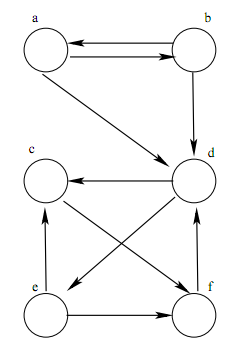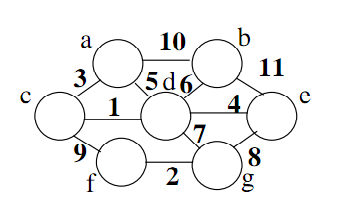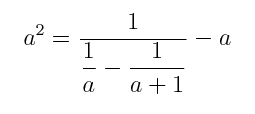 |
| (Textbook. Click for information.) |
Analysis of Algorithms
Spring 2012
Recitation 13
Final Exam Review
Partial Answers
|
CS 3343/3341 Analysis of Algorithms Spring 2012 Recitation 13 Final Exam Review Partial Answers |

|
| |||||||||||||||||||||||||||||||||||||||||||||||||

| Action | Contents of Piority Queue (* = removed) | ||||||
|---|---|---|---|---|---|---|---|
| Remove & Relax | a | b | c | d | e | f | g |
| Initial | 0 | ∞ | ∞ | ∞ | ∞ | ∞ | ∞ |
| a | 0* | 10 | 3 | 5 | ∞ | ∞ | ∞ |
| c | 0* | 10 | 3* | 4 | ∞ | 12 | ∞ |
| d | 0* | 10 | 3* | 4* | 8 | 12 | 11 |
| e | 0* | 10 | 3* | 4* | 8* | 12 | 11 |
| b | 0* | 10* | 3* | 4* | 8* | 12 | 11 |
| g | 0* | 10* | 3* | 4* | 8* | 12 | 11* |
| f | 0* | 10* | 3* | 4* | 8* | 12* | 11* |


|
Subset-Sum Problem (SS): Start with a set A of positive integers and a desired sum S. The decision question: Is there a subset A' of A such that sum( a | a in A' ) = S? |
|
Partition Problem (PART): Start with a set A of positive integers. The decision question: Is there a subset A' of A such that sum( a | a in A' ) = sum( a | a in A - A' )? [Here A - A' is the complement of A' in A.] |
|
| ||||||||||||||||||||||||||||||||||||||||||